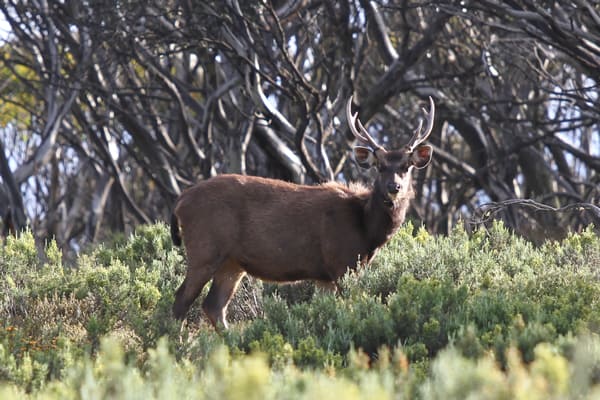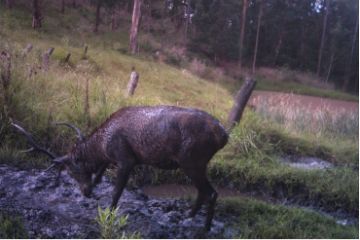Thanks to the help of our supporters the Invasive Species Council has enjoyed a strong track record of triggering political action. On the issue of feral deer, this response has been urgently needed, with plagues of deer now recognised as Australia’s worst emerging pest animal problem.
Across New South Wales and Victoria, we have played a critical role in shifting a hunter-orientated mindset of governments. Our work with farmers and local councils over many years has led to the NSW Government removing the protected status of feral deer, enabling this pest to be managed like any other and ending a management regime that protected deer purely as a resource for hunters.
Progress made in Victoria
In October 2020, after pressure from ourselves and the Victorian National Parks Association, the Victorian Government released a new deer control strategy that for the first time reflects the fact deer must be managed to limit their impacts. Then in December 2020, the state government announced $18.25 million for deer control, to be used over the next four years. This commitment is a clear sign of a willingness to mitigate the impacts of feral deer.
We established a deer project officer in Victoria in November 2020 to improve our ability to advocate for more effective deer control policy and actions and build relationships among those concerned about the impacts of feral deer. Special thanks to The Ross Trust for funding this role so far.
UPDATE: In November 2021, the Victorian Government released its final feral horse plan for the Alpine National Park, recognising the importance of integrating feral deer control with control of feral horses.
Peter Jacobs
DEER PROJECT OFFICER (VICTORIA)
ISC has made huge inroads into raising awareness of the impacts of feral deer, the need for effective control and presenting solutions. In Victoria we have been instrumental in establishing a new Victorian Deer Control Community Network and positioning ourselves with government to influence deer control policy and planning. In Tasmania we showed leadership by presenting a strategy to the Tasmanian Government and community that outlined an achievable way forward to deal with the wicked and divisive problem of feral deer.
Teaming up in Tasmania
In Tasmania, we teamed up with the Bob Brown Foundation to develop the way forward for the Tasmanian Government, which has been reluctant to act to control exploding feral deer populations and stop the spread of deer into the Tasmanian Wilderness World Heritage Area and other special places.
Our landmark report, Feral Deer Control: A Strategy for Tasmania, was released in August 2021 and identifies a clear pathway for how Tasmania can apply a biosecurity-focused approach to the management of feral deer and provides steps to remove deer from all but the traditional deer range where they were found many decades before.
UPDATE: In November 2021, due to our strategy and resulting pressure, the Tasmanian Government released its own draft deer management plan. While this plan set aside areas for deer eradication and acknowledged that this issue cannot be managed by hunters alone, it falls well short of solving this issue — having no mention of environmental impact, no targets, no measurements, no timeline and no budget commitment. Most disturbing, it endorses the retention of feral deer in the Tasmanian Wilderness World Heritage Area.
Momentum building at a national level
We have also made progress at a national level, with the appointment of Australia’s first ever national deer coordinator in August 2020. This role will coordinate action to tackle feral deer populations and reduce the damage feral deer cause to Australia’s agricultural businesses and environment.
We still have work to do – Victoria and Tasmania still list deer as protected or partially protected wildlife for game purposes and the Tasmanian Government has released a weak draft plan that has little chance of working.
So much is at risk, right now, you would struggle to find a national park free of feral deer in Victoria. Sadly, in Tasmania, these invasive species have moved into the iconic Walls of Jerusalem National Park and without decisive action will occupy the area traversed by the Overland Track in Cradle Mountain – Lake St Clair National Park. Our supporters play a vital role in allowing us to continue these campaigns.
Christine Milne AO
Invasive Species Council Ambassador
The Bob Brown Foundation commissioned the Invasive Species Council to write a thorough, evidence-based strategy outlining the problem with feral deer in Tasmania and proposing a solution. Bob and I could not be happier with the result. It is exactly what we hoped for, a national perspective and Tasmania-specific solution. The strategy will be widely used by NGOs and policy makers across Australia. Congratulations to Peter Jacobs and the team for making such a great contribution to tackling the problem of feral deer.
What’s next?
We have the science to guide us but over the year ahead, we need the resources to educate Australia on this huge issue and work to protect Australia’s incredible national parks, world heritage sites and other bushland areas from the impacts of feral deer.




